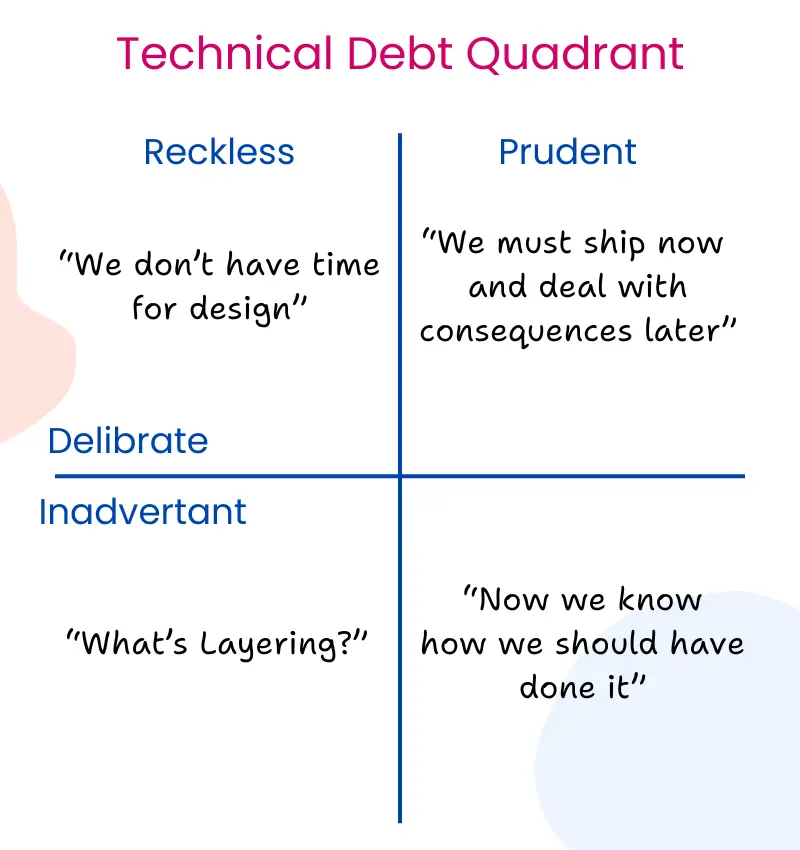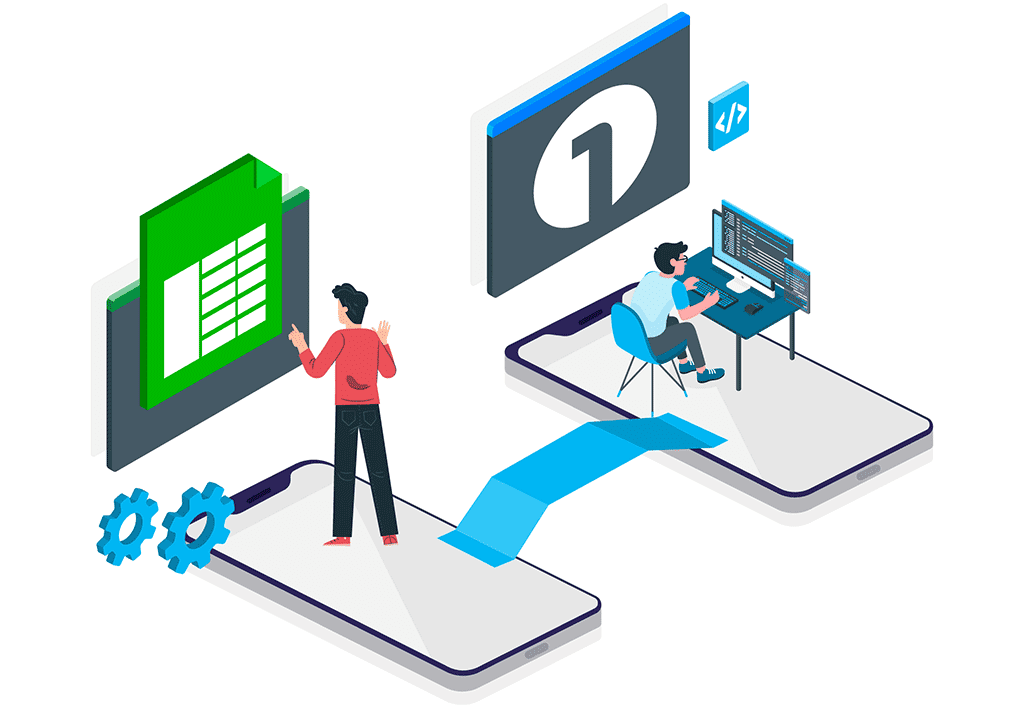Understanding and Managing Technical Debt in Software Development
Strategies for Handling Technical Debt
Share:

Get to know about:
What is Technical Debt?
Technical Debt is a software development metaphor representing the consequences of bad coding practices. It’s akin to financial debt, accruing interest over time. It builds from compromises during development and developers taking shortcuts to meet deadlines or deliver features quickly.
While these shortcuts may expedite initial development, they often have long-term consequences. It can exist in various forms, including messy code, poor architecture, high bugs, and slower development velocity.
As per a report published by McKinsey, tech debt at 220 companies across five geographies and seven sectors revealed a significant correlation between technical debt and business performance.
Origin of the term 'Technical Debt'
Software developer Ward Cunningham coined the term “technical debt” in the early 1990s. Cunningham, also known for creating the first wiki and contributing to the Agile Manifesto, came up with this idea while working on the WyCash financial modelling software project.
He compared the concept to financial debt, where developers take shortcuts or make compromises during software development. These shortcuts accumulate as a “debt” that needs to be paid off later. We can say that it is like borrowing time to meet deadlines or deliver features quickly, but eventually, it leads to increased complexity and maintenance costs. This term has become widely recognized in the software development community.
What are 4 components of Technical Debt Quadrant?
This model helps to visualize and categorize different types based on their impact and intentionality.
This model was popularized by Martin Fowler in his blog post “Technical Debt Quadrant” in 2009. It divides technical debt into four quadrants based on two axes: reckless/prudent and deliberate/inadvertent.
Here’s an overview of each quadrant:
Reckless and Intentional: This quadrant denotes technical debt that is accrued deliberately due to conscious decisions. Many developers and professionals prioritizing immediate gains over long-term advantages. Examples include expedited shortcuts to meet deadlines and disregard for code quality in favor of swift feature delivery. While such technical debt may offer immediate benefits, it often leads to elevated long-term maintenance expenses and heightened risk of forthcoming complications.
Prudent and Intentional: Here technical debt is accumulated deliberately but with careful foresight and strategic planning. It encompasses trade-offs between short-term expediency and enduring objectives while maintaining cognizance of the repercussions.
Reckless and Unintentional: This quadrant illustrates technical debt that is inadvertently amassed due to lack of awareness, expertise, or discipline. It frequently results from careless or hurried development practices such as indiscriminate code duplication, neglect of code reviews, or failure to adhere to coding standards.
Prudent and Unintentional: Technical debt in this quadrant is unintentionally accrued despite efforts to prioritize quality and maintain best practices. It may arise from factors beyond developers’ control, such as evolving requirements, stringent deadlines, or resource constraints.
By understanding the Technical Debt Quadrant, teams can categorize and prioritize technical debt more effectively, enabling them to make informed decisions about when and how to address it to ensure the long-term sustainability and success of their software projects.
What are 7 types of Technical Debt?
As we analyze an organization’s software development landscape, it’s important to recognize the various types of technical debt that may impact the projects.
1. Firstly, there’s code debt. This occurs when developers knowingly take shortcuts to meet tight deadlines, resulting in poor code structure, duplicated code, and lack of documentation. Addressing code debt is crucial for maintaining code quality and reducing future maintenance costs.
2. Next, you can have design debt, which arises from shortcomings in the overall architecture or design of software systems. Tight coupling between components and lack of scalability are common symptoms of design debt. By prioritizing architectural improvements and refactoring efforts, you can mitigate design debt and ensure your systems remain flexible and maintainable.
3. Testing debt is another area of concern. Insufficient test coverage and reliance on manual testing processes can lead to increased risk of regressions and bugs going undetected. In our opinion, by investing in comprehensive automated testing strategies, you can minimize testing debt and improve overall software quality.
4. Infrastructure debt refers to deficiencies in the underlying technology stack and deployment processes. Outdated libraries and inefficient deployment pipelines can hinder development velocity and limit scalability. Addressing infrastructure debt involves upgrading dependencies, adopting modern technologies, and streamlining your deployment processes.
5. Documentation debt, as the name suggests it occurs due to inadequate or outdated documentation can impede knowledge sharing and system understanding. By prioritizing documentation as part of our development process and regularly updating it to reflect changes, you can mitigate documentation debt and improve team efficiency.
6. Process debt refers to deficiencies in our software development processes and practices. Inconsistent coding standards and ad-hoc release management practices can lead to inefficiencies and increased risk of errors. By establishing clear development workflows and enforcing best practices, you can reduce process debt and improve overall development efficiency.
7. Legacy Systems – A major contributor to technical debt
Dealing with legacy systems can feel like walking through a maze of old code and outdated technologies. These systems have been around for a while, and they often come with their fair share of technical debt. When these systems were built, many developers did not have access to the latest standards or best practices. As a result, the codes were usually very hard to understand.
The real challenge is when someone tries to add new features or update the application; it’s like trying to fit a square peg into a round hole. Working around the existing code can result in an increase. Programmers usually end up adding quick fixes or patches to get things working, but it only makes the problem worse in the long run. These systems probably already accumulated a lot of it over the years. It’s like trying to untangle a knot that’s been growing for decades. It is a difficult task and not at all easy.
By proactively addressing these various types of technical debt, you can ensure the long-term maintainability and sustainability of our software systems, ultimately driving business success.
How can technical debt be reduced or controlled?
This is not just an issue for IT; it can also have business, financial, and security implications. A considerable number of CIOs still need help handling it effectively.
Here are top 5 ways to reduce technical debt –
1. No-Code/Low-Code Solutions:
The easiest and best way is to embrace no-code or low-code platforms that will significantly reduce it by empowering non-technical users to build applications with minimal reliance on custom code. No-Code tools democratize application development. It reduces the burden on development teams, freeing them to focus on high-value tasks and strategic initiatives. Integrating no-code/low-code solutions into the development ecosystem can help mitigate technical debt by accelerating time-to-market, reducing development overhead, and promoting collaboration between business stakeholders and IT teams.
2. Regular Code Refactoring:
Make it a regular practice to schedule code refactoring sessions, as it is essential for keeping program manageable. Refactoring involves restructuring existing code without changing its external behavior to improve readability, maintainability, and efficiency. This will improve the quality of code and the proactive approach reduces the accumulation of technical debt over time.
3. Automated Testing:
We recommend you to implement a robust automated testing strategy is paramount for identifying and addressing technical debt early in the development process. Automated tests, including unit tests, integration tests, and regression tests, help detect bugs, regressions, and inconsistencies in the codebase. By running these tests regularly as part of continuous integration (CI) pipelines, developers can catch issues before they escalate into significant technical debt. Investing in comprehensive test coverage not only improves code reliability but also instills confidence in making changes to the codebase, facilitating faster iteration and reducing the risk of introducing new technical debt.
4. Code Reviews:
Code reviews can help in maintaining code consistency, identifying architectural flaws, and prevent the accumulation of technical debt. It is advised to foster a culture of code review within the team so that organizations can leverage collective knowledge and experience to produce higher-quality code, reducing the likelihood of future technical debt accrual.
Continuous Integration/Continuous Deployment (CI/CD): The adoption of CI/CD practices has become increasingly prevalent in modern software development workflows. The Agile Manifesto, formulated in 2001 by a group of software development practitioners, advocates for continuous integration as a cornerstone of Agile methodologies. The principles of CI/CD, including automated builds, automated testing, and frequent deployments, help streamline the software delivery process and minimize technical debt by facilitating rapid feedback loops and reducing the risk of regression errors.

Take advantage of no-code to get ahead of your competitors.
No-Code development platform for all your unique projects.









